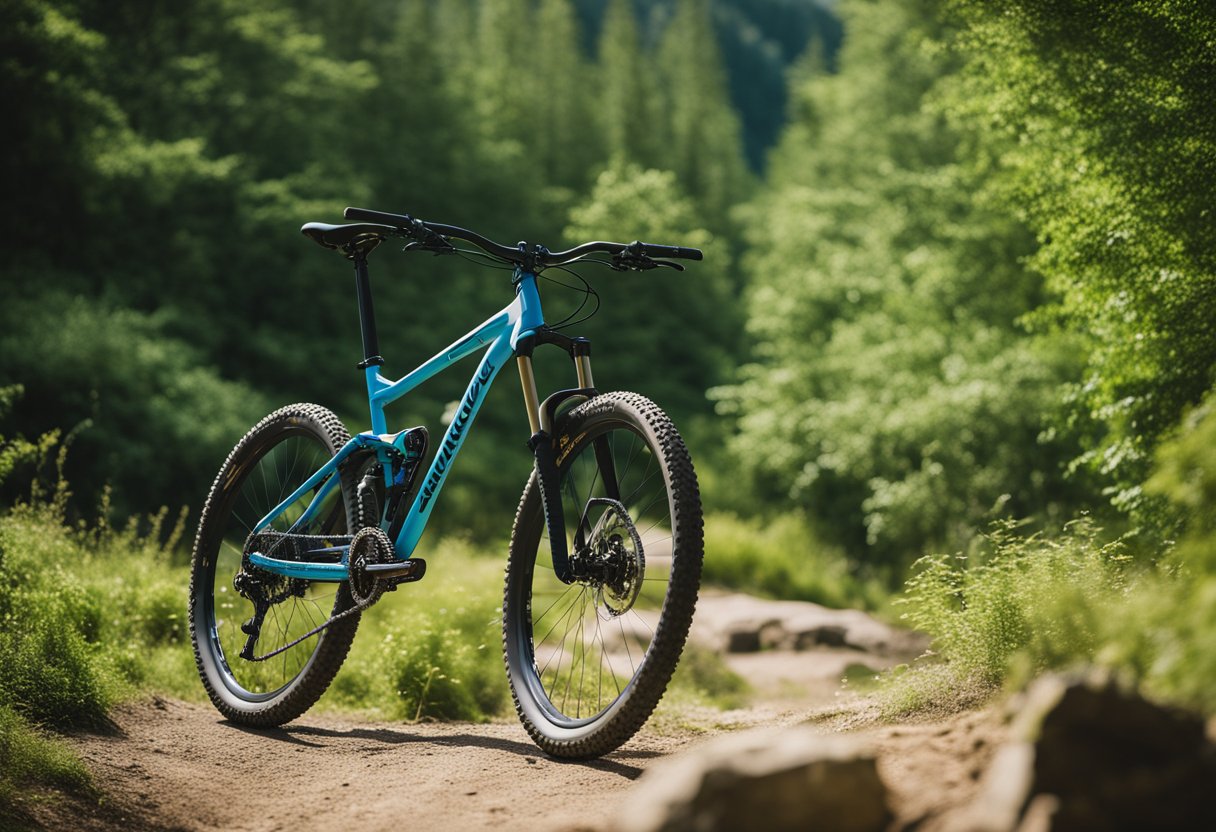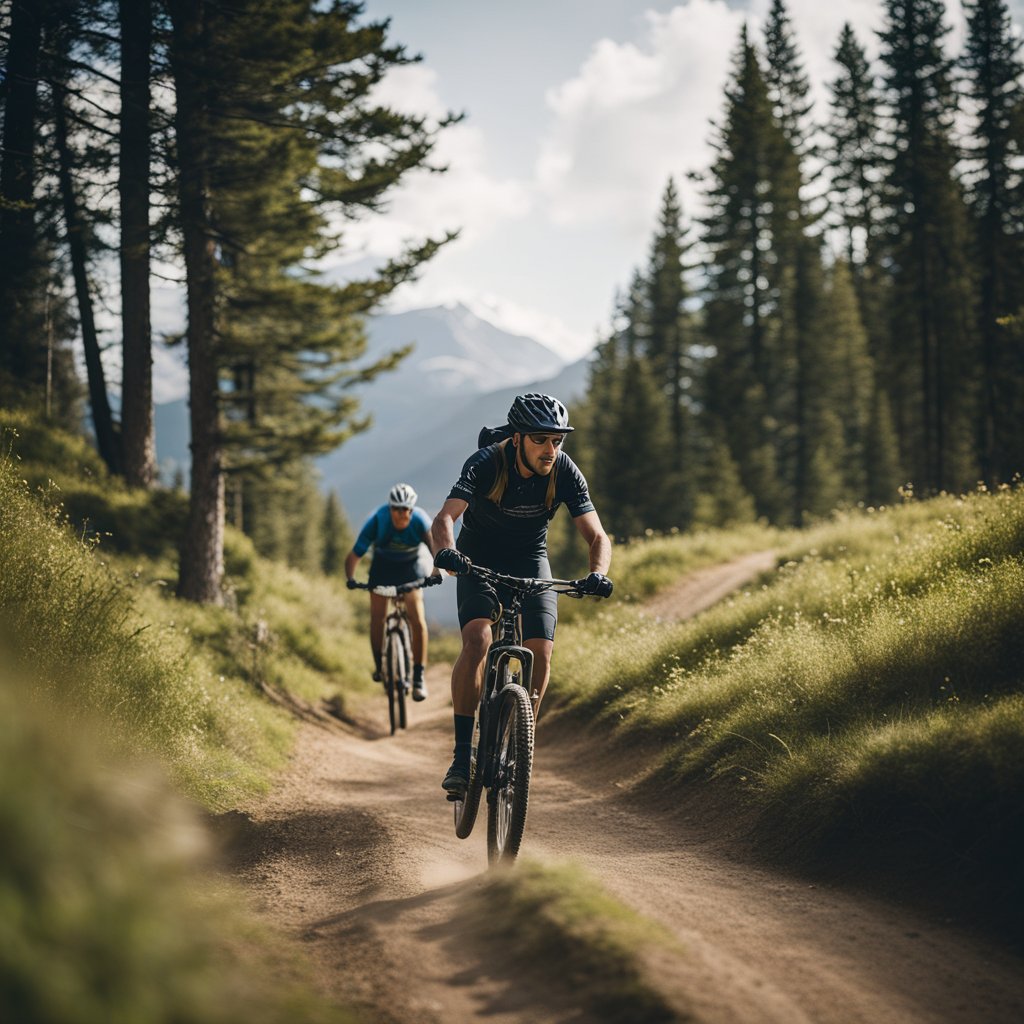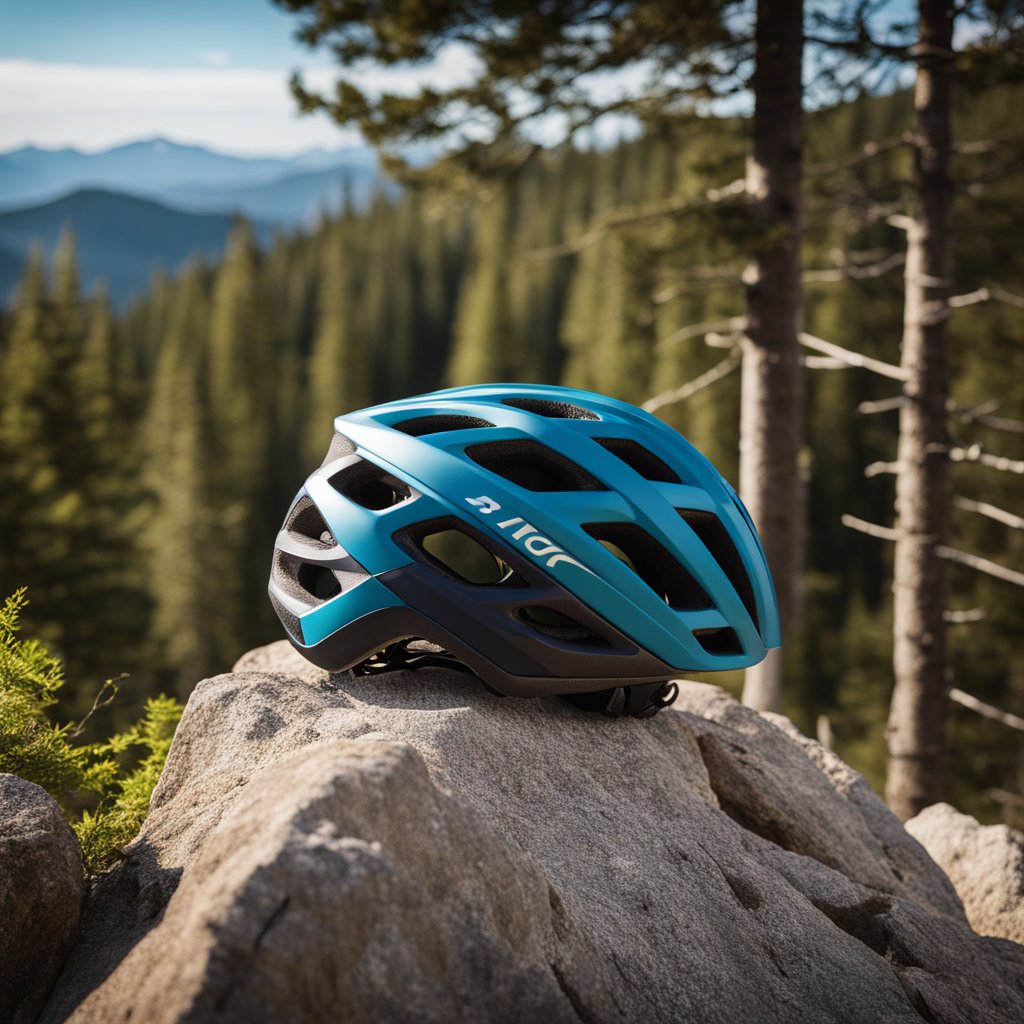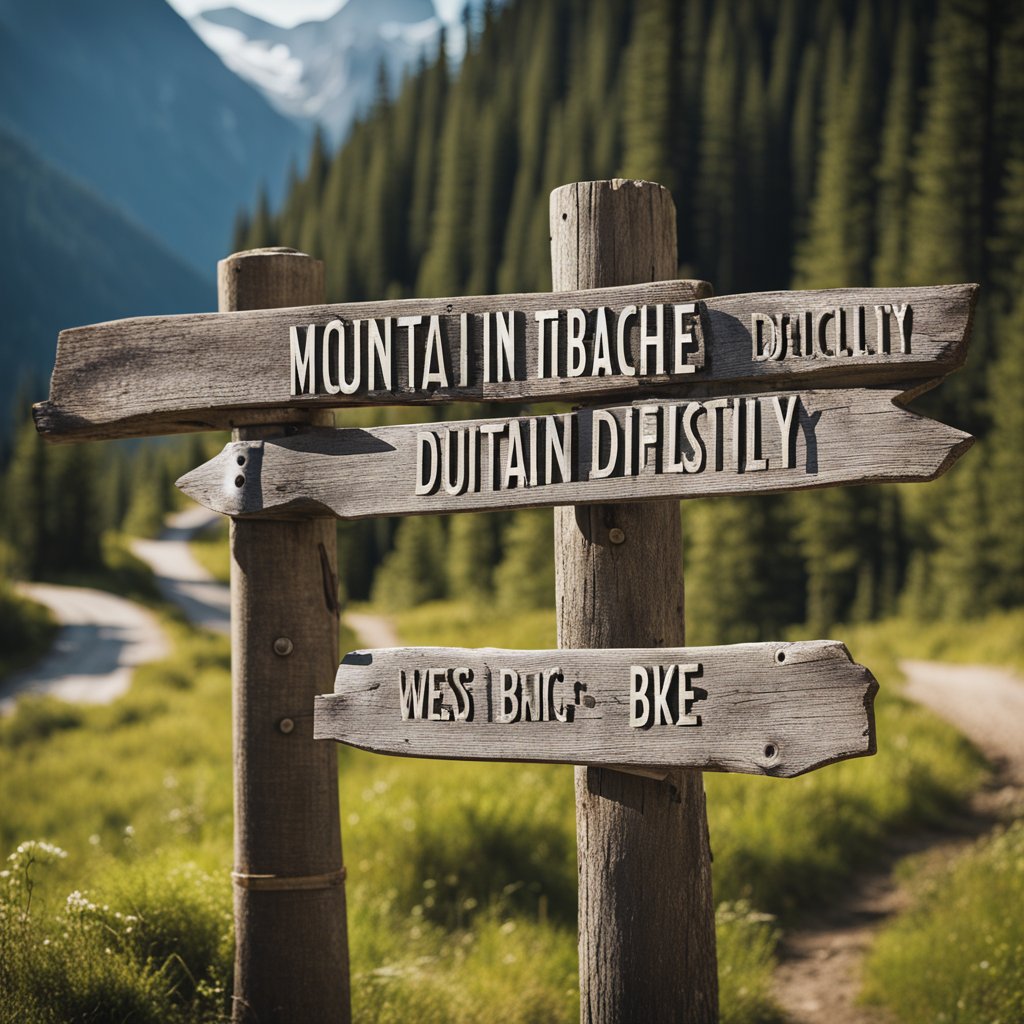Starting with mountain biking can be an exhilarating experience that offers a unique blend of joy and adventure. Imagine pedaling through scenic trails, feeling the breeze against your skin, and the sense of achievement with every new trail conquered. As a beginner, your first ride might seem daunting, but with the right approach, it will soon become a cherished activity. Learning the basics is key to enjoying the ride safely and building up your confidence on the trails.
Mountain biking is more than just a sport; it’s a way to connect with nature and explore the great outdoors in an active way that also challenges your body and mind. Whether you’re looking for a tranquil escape or an adrenaline rush, riding on two wheels allows you to access remote locations and enjoy vistas that might otherwise be unreachable. Remember, every expert rider was once a beginner too, so patience and practice are essential.
When gearing up for your initial foray into mountain biking, consider starting on easier trails that match your current fitness level and technical ability. This approach helps in gradually building your skills without being overwhelmed. With each ride, you’ll find yourself becoming more comfortable and proficient, paving the way for more challenging adventures. The key is to take it at your own pace and savor the moments of learning and discovery along the way.
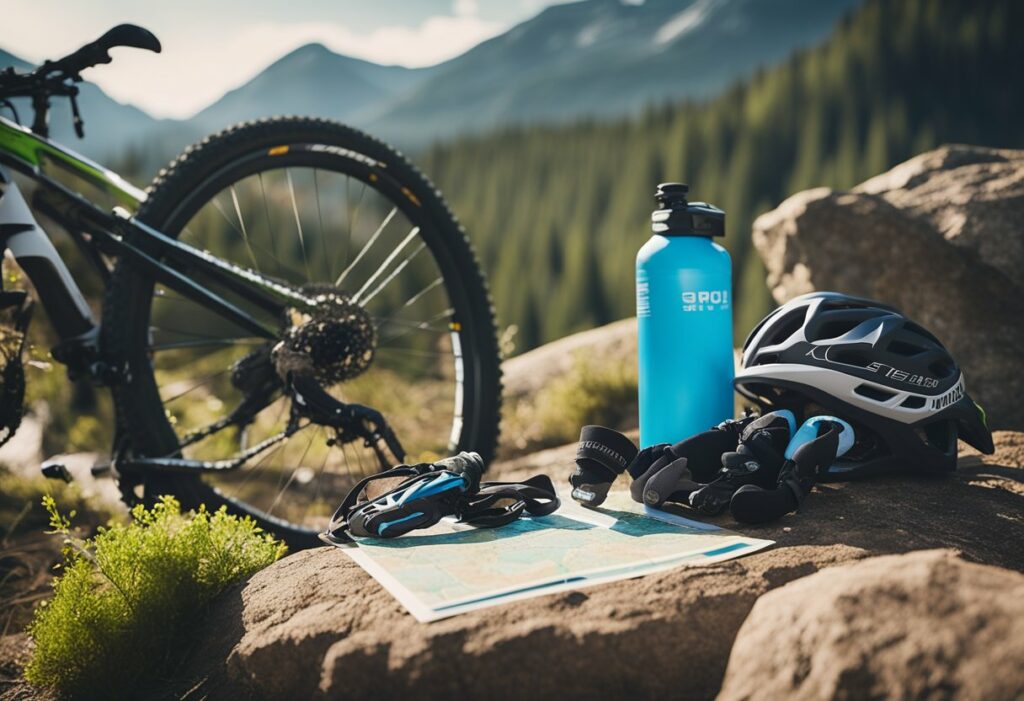
Choosing the Right Gear
When you embark on your mountain biking journey, having the right gear is as crucial as the adventure itself. The gear you choose not only enhances your riding experience but also ensures your safety on the trails.
Understanding Bike Types
Hardtail Mountain Bikes: Ideal for beginners, they come with front suspension to absorb shocks from the front wheel. These are simpler maintenance-wise and generally less expensive than their full-suspension counterparts. Full-suspension bikes, with both front and rear suspension, provide better control and comfort but at a higher price point and added maintenance complexity. Depending on your riding terrain and comfort preferences, your choice between a hardtail and a full-suspension mountain bike can greatly affect your riding experience.
Essential Equipment for Safety
- Helmets: Your most important piece of safety gear. A proper mountain bike helmet should cover your forehead and the back of your head. Always opt for a helmet that meets safety standards, and ensure it provides a snug fit.
- Protective Gear: Consider additional protection like knee pads, elbow pads, and a spine protector, especially if you’re riding on rough terrain.
- Gloves: They provide grip stability, protect your hands during falls, and keep your fingers comfortable in all weather conditions.
- Chamois: Padded biking shorts are essential for preventing discomfort and chafing on longer rides.
- Hydration Pack: Staying hydrated is key; a hydration pack keeps your hands free and carries your water supply effortlessly, often with additional space for tools and snacks.
By prioritizing the right mountain bike and essential equipment for safety, you’re setting yourself up for a successful and enjoyable introduction to mountain biking. Remember, investing in quality gear is not just about comfort but also about your safety on the trails.
Bike Anatomy 101
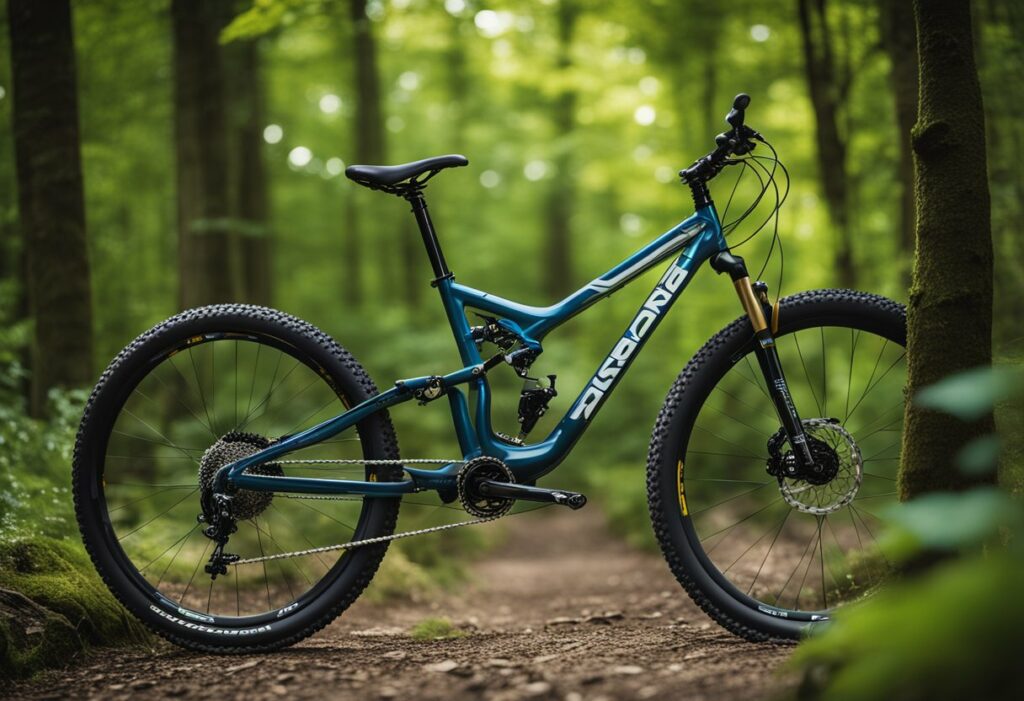
When you’re starting with mountain biking, knowing your bike’s anatomy is crucial for better handling and maintenance. Let’s break down the key components that make up your mountain bike.
Frame and Suspension
Your mountain bike’s frame is its backbone, providing structure and influencing how the bike handles rough terrain. Frames are typically made from materials like aluminum, carbon fiber, or steel, each with its own weight and durability characteristics. The suspension system is pivotal too – it helps absorb shocks from bumpy trails. You’ll find front suspension on almost all mountain bikes, which includes a suspension fork attached to the front wheel. If your bike also has rear suspension, it’s considered a full-suspension bike, offering a more comfortable ride on particularly rough trails.
Wheels and Tires
The wheels and tires of your mountain bike are your points of contact with the ground and can drastically affect your ride. Larger wheels, like 29-inch ones, roll over obstacles more easily, but might not be as agile as 27.5-inch wheels. Your tires should match your riding style and terrain. Aggressive tread patterns provide better grip in rough conditions, while smoother tires are suitable for well-maintained trails or gravel paths. Make sure to keep your tires properly inflated for optimal performance.
Mountain Biking Techniques
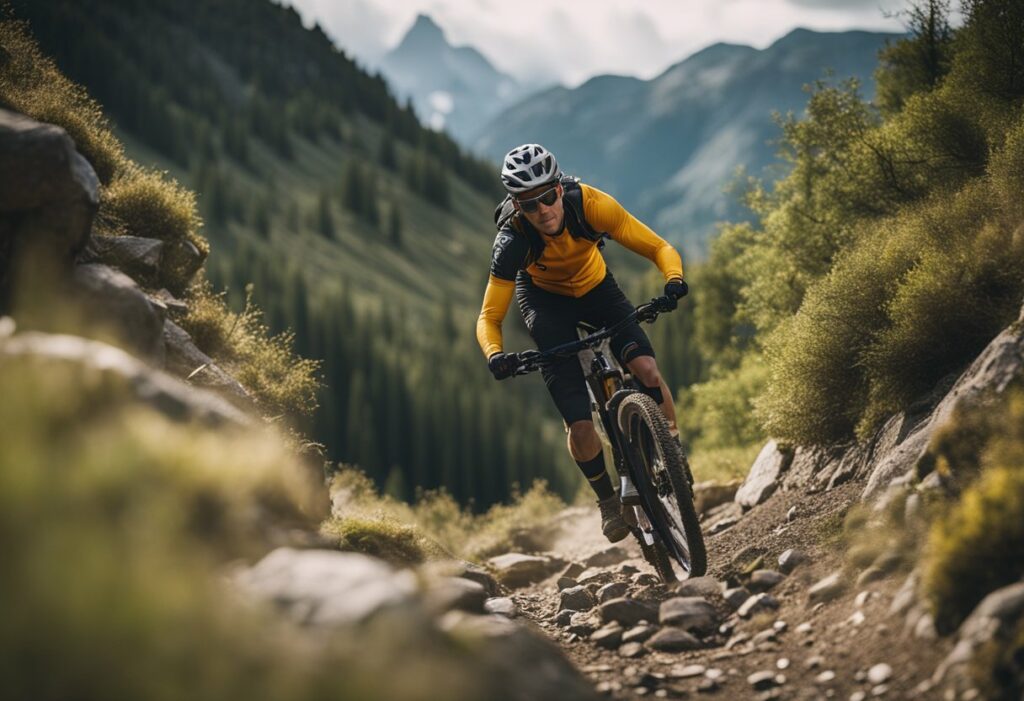
When beginning mountain biking, mastering various techniques will significantly enhance your control and enjoyment of the sport. Let’s dive into the skills you’ll want to develop, from basic handling and momentum maintenance to executing advanced maneuvers that will allow for a fluid and safe riding experience on a variety of terrains.
Basic Riding Skills
Bike Skills: You’ll first need to get comfortable with your bike. This means adjusting the riding position for maximal control and learning how your bike reacts to different kinds of terrain. The type of bike and adjustment can affect your handling and comfort, so take the time to get this right.
Control and Momentum: Always look ahead and anticipate obstacles to maintain momentum. When approaching cornering or climbing, your body position can greatly affect your bike’s traction. For climbs, shift your weight forward to maintain traction on the front wheel. When descending, move your weight back to prevent going over the handlebars.
Cornering: Effective cornering requires you to lean the bike more than your body, and to do so, you need to trust your bike’s traction. Enter corners with controlled speed, and aim to exit with slightly more speed than you entered.
List of Basic Riding Techniques:
- Adjust your bike fit
- Look ahead, not down
- Brake before entering turns
- Keep pedals level on rough terrain
- Use body position to manage traction
Advanced Maneuvers
Descent: When tackling a descent, your focus should be on controlling your speed without locking the brakes. This ensures you retain traction and steering ability. Lower your saddle if necessary to lower your center of gravity, and remember to always keep your heels down.
Jumps: Jumps can be thrilling but require confidence and practice. Start small and work your way up. Approach the jump with enough speed, lift off by preloading your body and pushing into the jump, and always aim to land on the downslope for a smoother transition.
Steps for Executing a Jump:
- Approach with controlled speed
- Compress your body slightly before the jump
- Extend your legs and arms to lift off
- Stay relaxed in the air
- Aim for a smooth landing on the downslope
As you get more confident with these techniques, continue practicing and refining each skill. With time, you’ll see your rides becoming more fluid and enjoyable. Remember that control is key – it keeps you safe and enables more fun on the trails!
Mastering the Trails
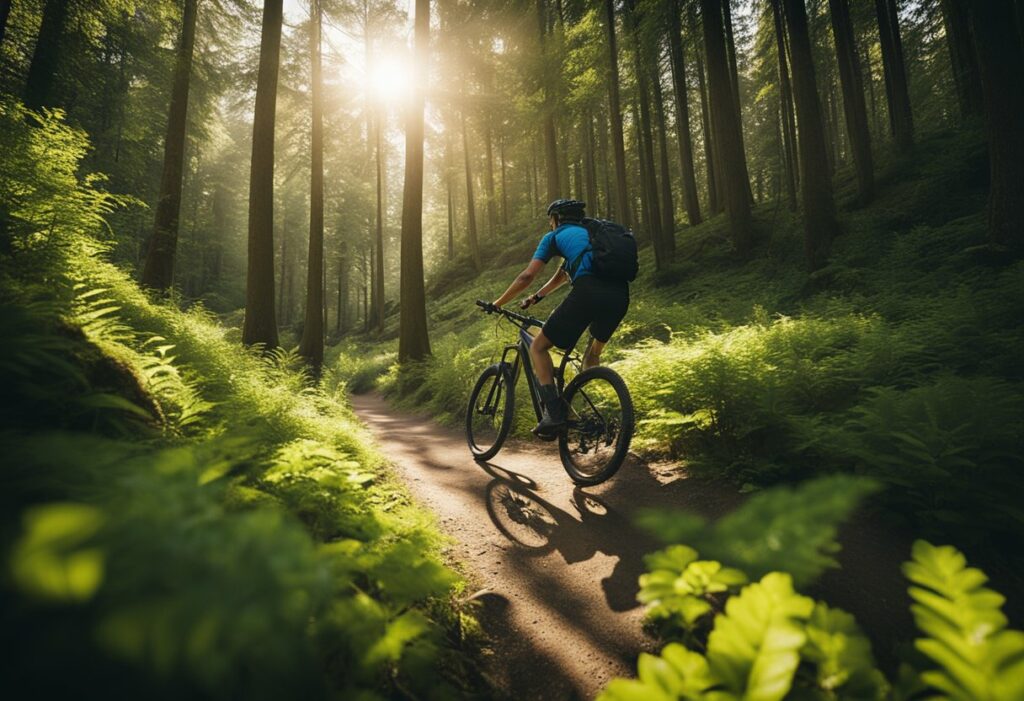
Before you hit the bike trails, it’s essential to understand different trail types and what to expect, as well as the importance of trail etiquette and safety to guarantee an enjoyable and secure ride.
Trail Types and Difficulty
When selecting a trail to ride, be sure to choose one that matches your skill level. Trail maps usually categorize paths by color codes, similar to ski slopes:
- Green: These are easy trails, perfect for beginners. They have minimal obstacles and are often relatively flat.
- Blue: Intermediate trails that may include small technical features, such as roots and rocks.
- Black Diamond: Advanced trails designed for experienced riders, featuring steep inclines and challenging obstacles.
- Double Black Diamond: Expert-level trails with steep, technical terrain requiring excellent bike control and riding skills.
Remember, cross-country trails are typically less technical and focus on endurance, while downhill and enduro trails offer a blend of challenging descents and technical features.
Trail Etiquette and Safety
When you’re out on the trails, being mindful of others and riding responsibly ensures safety for everyone.
Right-of-Way
- Cyclists going uphill have the right-of-way over those going downhill.
- When meeting hikers or equestrian users, slow down and give them space.
Stay Safe
- Always wear a helmet and appropriate safety gear.
- Carry a repair kit and know basic bike maintenance.
Be Prepared
- Check the trail map ahead of time and keep it with you.
- Take adequate water and snacks, especially for longer, more remote trails.
Enduro bikes and technical features on the trail require extra caution and specific handling skills to navigate safely. Happy riding, and remember to respect both the trails and your fellow trail users!
Riding Through Nature
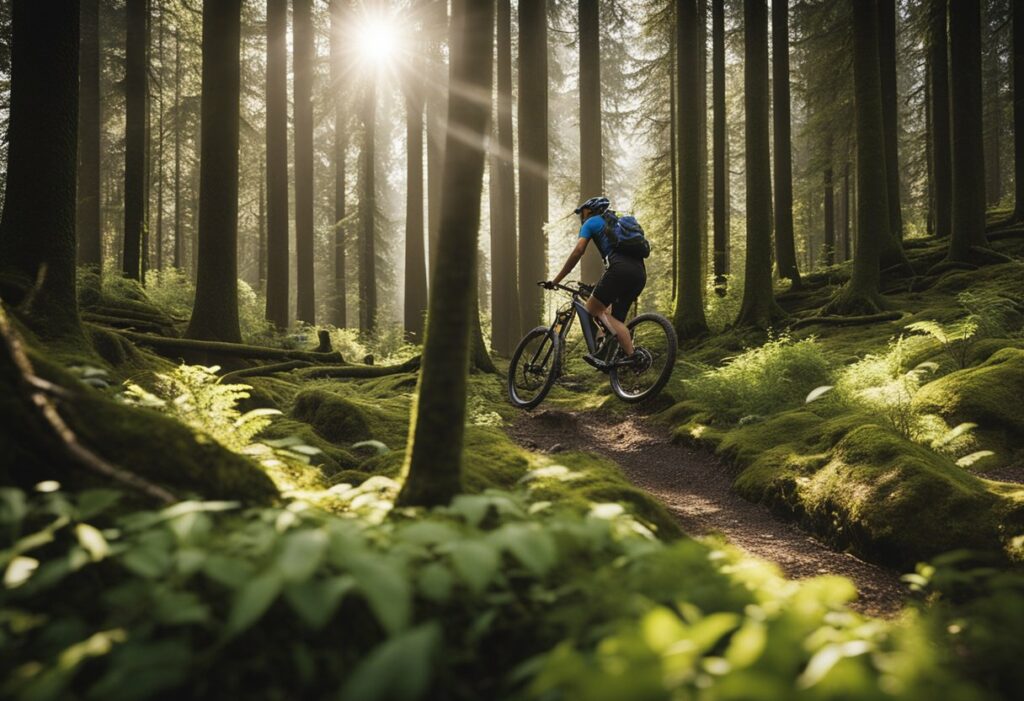
Embrace the elements and anticipate the thrill that comes with mountain biking through diverse landscapes—be it winding paths in the woods or steep mountain inclines. Your connection with nature will deepen as you pedal through varied terrains and weather conditions.
Terrain Adaptation
When you’re biking through nature, expect a mix of dirt trails, rocky paths, and the occasional stream crossings. In the mountains, you might encounter loose gravel that requires careful steering. Adapt your riding style to maintain balance and control; for woods with dense roots, it’s about finding the smoothest line and keeping your speed in check. On sand or snow, lower your tire pressures for better traction. Here’s a quick reference to adjust to different surfaces:
- Dirt: Keep a steady pace, use rolling resistance to your advantage.
- Rocks: Stand up on the pedals, let the bike float underneath you.
- Snow: Use wider tires, maintain a steady gear.
- Sand: Deflate tires slightly for stability, keep your weight back.
Weather Conditions
The whims of weather add a layer of unpredictability to your ride. Always check the forecast before heading out and be prepared with the appropriate gear. When navigating through wet conditions, remember that traction decreases, so take turns with extra caution and brake earlier than you would on dry terrain. Facing strong winds? Lean into it and reduce your profile to minimize resistance. For a safe and enjoyable ride, always dress in layers and have waterproof clothing ready for any sudden changes. Remember, the conditions can dictate your pace, so respect nature’s signals and ride accordingly.
Maintenance and Repairs
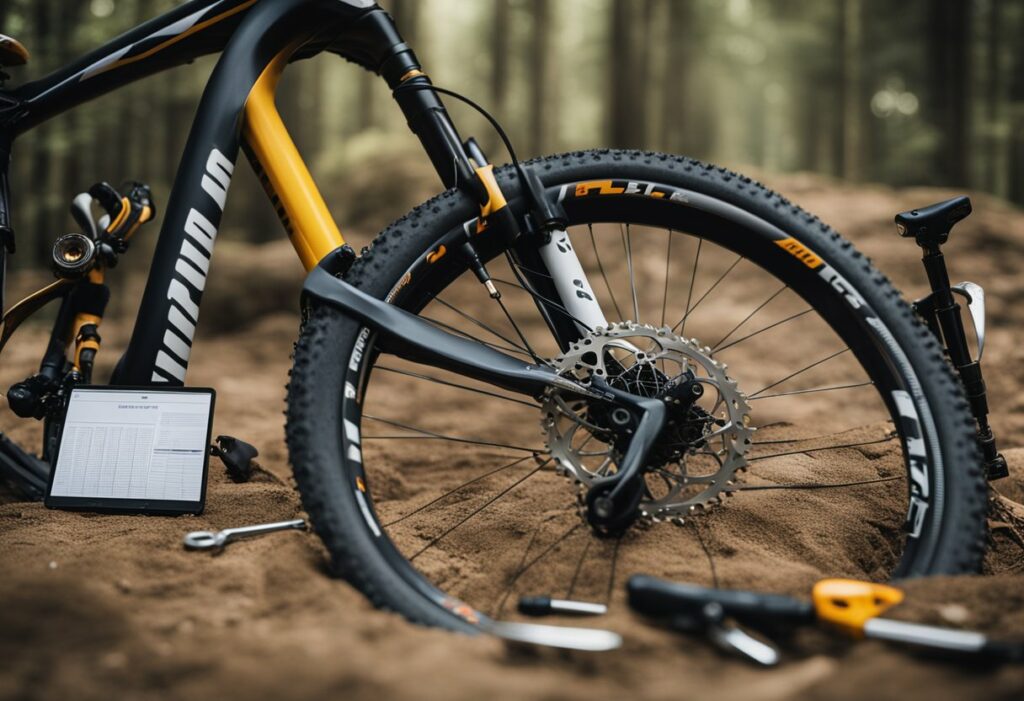
Keeping your mountain bike in top condition ensures a safe and enjoyable ride. Regular maintenance and knowing how to tackle on-trail repairs are key skills you’ll need.
Routine Bike Care
Your mountain bike is your trusty companion on the trails, and like any good relationship, it requires attention and care. Here’s how you can keep it running smoothly:
- Cleaning: After each ride, give your bike a gentle wash to remove dirt and grit. Pay special attention to the chain and gears.
- Chain Maintenance: Lubricate your chain regularly to reduce wear and tear. A well-lubricated chain makes for smoother rides and prolongs the lifespan of your drivetrain.
- Brakes: Check your brake pads for wear and ensure they are aligned correctly. Listen for any scraping or squeaking, which indicates it’s time for a maintenance check.
- Tire Pressure: Keep tires inflated to the recommended pressure. This reduces the risk of punctures and ensures better control.
| Maintenance Task | Frequency |
|---|---|
| Clean your bike | After every muddy ride |
| Lubricate chain | Every few rides |
| Check brakes | Before every ride |
| Tire pressure | Before every ride |
On-Trail Fixes
Despite your best efforts, sometimes things go wrong mid-ride. Here’s what you should have on hand and how to address common issues:
- Spare Tube: Always carry a spare tube. If you get a flat, replace the tube instead of patching it on the trail to save time.
- Multi-tool: A good multi-tool can tighten loose bolts, adjust your saddle, and make other small tweaks necessary to keep your bike functional until you’re back home.
- Brake Fixes: If your brakes start to feel less responsive, check for obstructions or misalignment. Use your multi-tool to adjust as needed.
- Quick Cleaning: A small brush or cloth can be used to remove debris that might be hindering your bike’s performance.
Keeping a compact kit on your bike with these essential tools and spare parts will help you handle most common issues and keep your ride going.
Training and Fitness
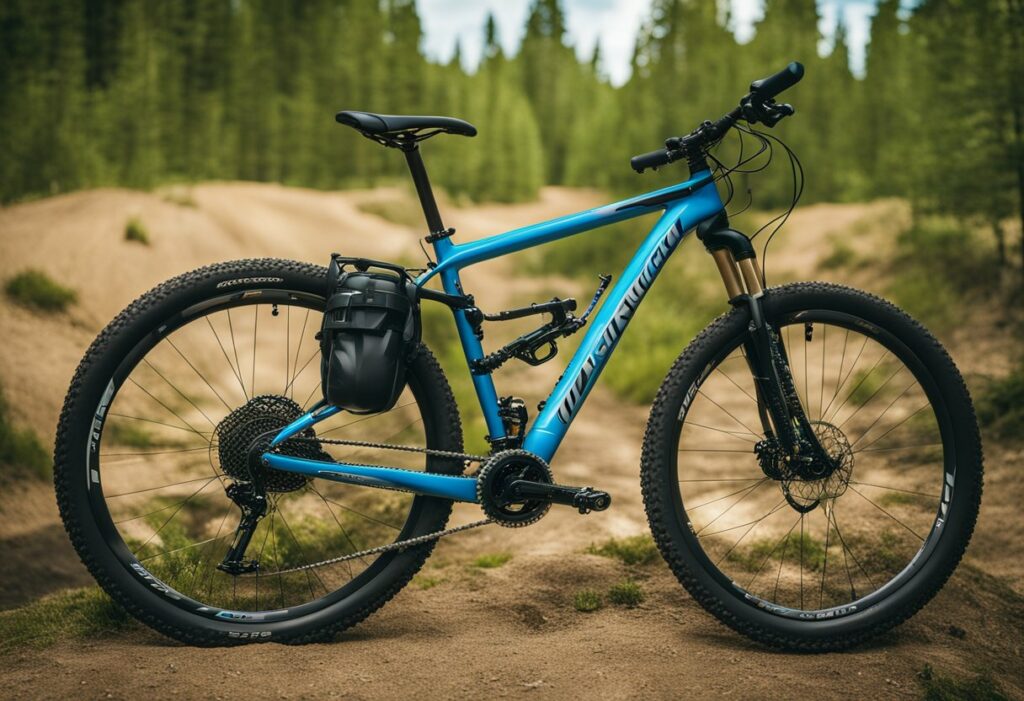
When you’re starting with mountain biking, your fitness level can be as crucial as your equipment. You’ll need a mix of endurance, strength, balance, and stability to tackle the trails.
Endurance is key for long rides, so incorporate cardiovascular exercises such as jogging or rapid sessions on an elliptical machine to increase your stamina.
For strength, focus on exercises that engage your core, legs, and arms—areas that you heavily rely on when you navigate through tough terrain. Squats, lunges, and push-ups are great for building muscle power.
Balance and stability exercises are also important, as they help you maintain control of your bike during tricky climbs or descents. Try yoga or Pilates to improve your flexibility and core strength, which will help you maneuver your bike more effectively.
Here’s a brief training routine to get you started:
- Cardio: 30 minutes of cycling or running
- Strength training: 2 sets of 10 squats, lunges, and push-ups
- Balance practice: 10 minutes of yoga or balance-focused exercises
Remember to start slowly and listen to your body. As you become fitter, you can gradually increase the intensity of your workouts. And don’t forget the importance of rest—your muscles need time to recover and grow stronger. With consistent training, you’ll see improvements in your mountain biking performance!
Performance Optimization
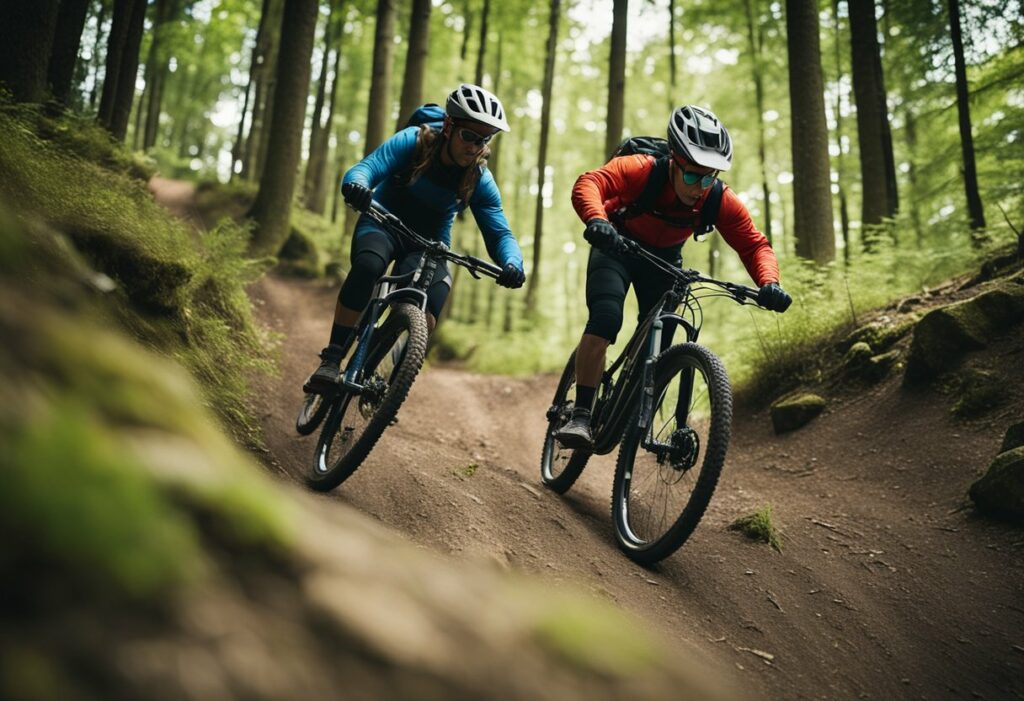
Improving your mountain biking performance hinges on optimizing both your bike setup and your riding technique. Let’s delve into specifics about how you can upgrade your bike for increased speed and efficiency, and how to refine your riding style for smoother, more efficient travel over varied terrain.
Upgrade Tactics
Bike Upgrades: To enhance your mountain bike’s performance, consider these specific upgrades:
- Frame Material: Lighter materials like carbon fiber or aluminum can reduce weight and increase speed.
- Pedals: Switch to clipless pedals for better power transfer and control.
- Shift Mechanism: Invest in a smoother, more reliable shifting system to maintain momentum and reduce energy loss on the trail.
When to Upgrade: Upgrade when you feel that your current components are limiting your progress or when wear and tear dictate the need for replacement.
Riding Efficiency
Efficient Techniques: Your riding efficiency is just as important as your equipment. Focus on these areas for a more fluid ride:
- Gear Shifting: Learn to anticipate the trail and shift gears proactively to maintain a steady cadence.
- Body Position: Adjust your body position dynamically to handle climbs, descents, and obstacles efficiently.
Practice Drills: Regularly practice technique drills to internalize efficient movements and make them second nature as you ride.
The Mountain Biking Community
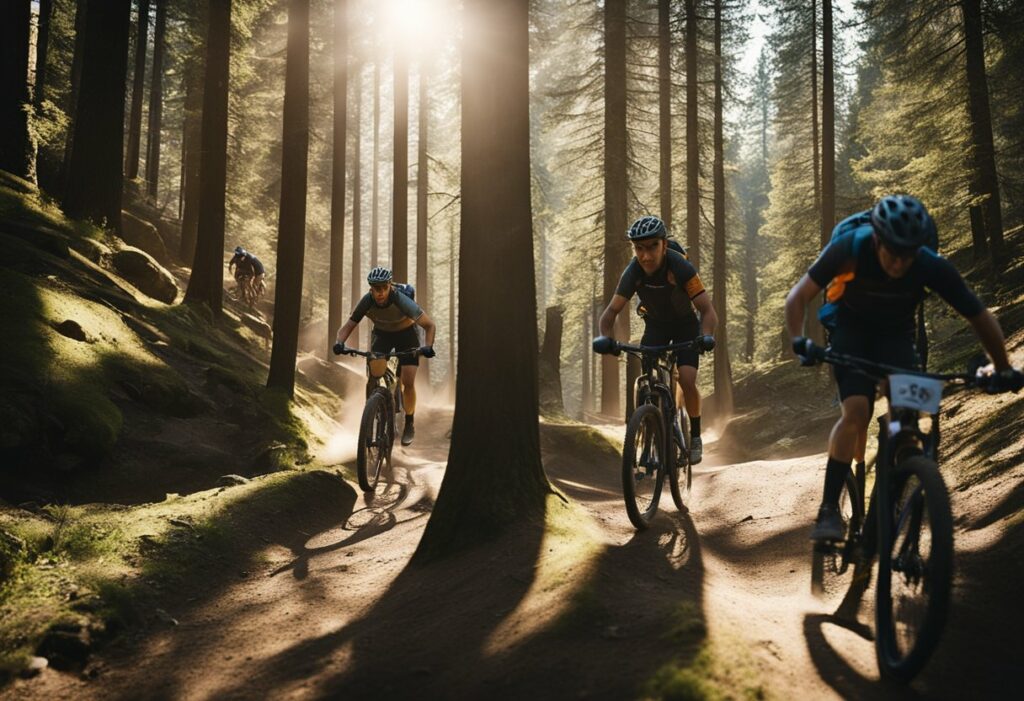
When you dive into mountain biking, you’re not just picking up a new hobby, you’re becoming part of a vibrant community. This group is filled with enthusiasts ranging from casual riders to professionals, all connected through their love of riding. Whether you’re looking to compete in events, join local rides, or simply connect with fellow bikers, the community is ready to welcome you with open arms.
Events and Races
Explore Various Competitions:
- Cross-country (XC) Races: Often part of a series and ideal for riders of mixed abilities.
- Downhill (DH) Races: For those seeking high-speed thrills on steep, challenging terrains.
- Enduro Events: A blend of XC and DH, with timed downhill runs and untimed uphill sections.
Finding the right events and races can be as simple as checking with your local bike shops or visiting cycling forums online. Competing can be a thrilling way to test your skills, improve your riding, and forge lasting friendships within the community.
Local Groups and Resources
Connect with Local Riders:
- Meet-up Groups: Join local riding groups to explore new trails and learn from experienced riders.
- Clinics and Workshops: Professionals often host sessions to teach techniques from basic to advanced levels.
Whether you’re into serene trail rides or intense downhill sessions, your local biking groups are a treasure trove for resources. They can connect you with beginner-friendly advice or the latest pro tips to level up your riding style. You’ll find that these connections not only improve your techniques but also enhance your overall enjoyment of mountain biking.
Safety and Protection
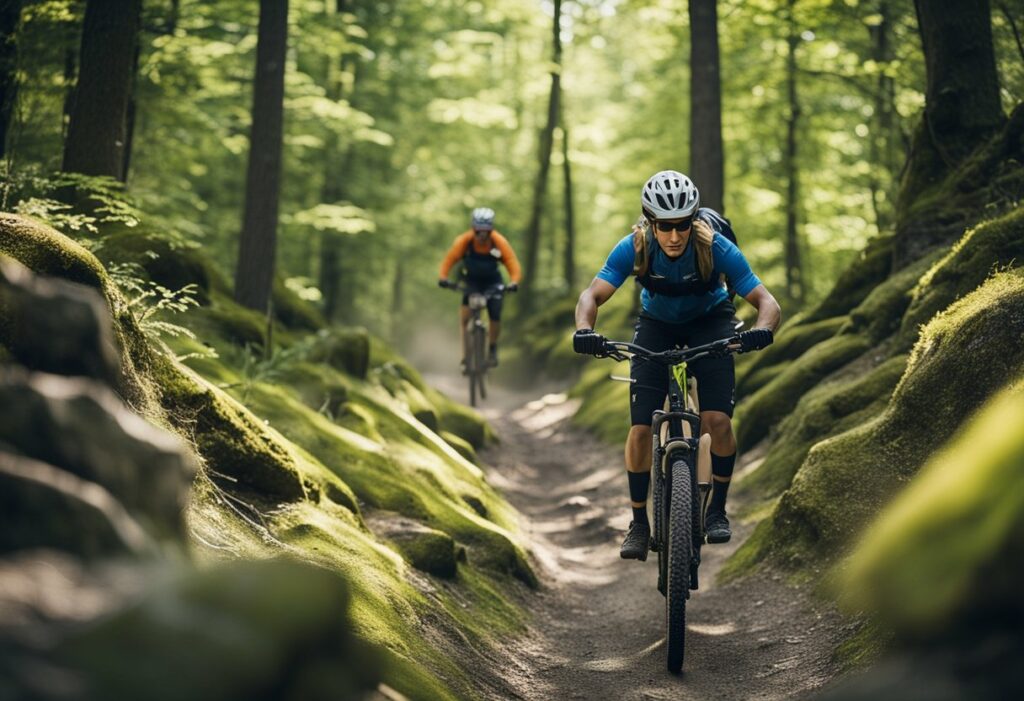
Embarking on mountain biking adventures means prioritizing your safety at all times. Below, you’ll learn about the essential protective equipment you need and tips for riding safely.
Protective Equipment
Helmet: Always wear a helmet when mountain biking. It’s your best defense against head injuries and should meet safety standards specific to the sport.
Protective Gear: Invest in quality protective gear, including:
- Bike Gloves: To improve grip and protect your hands from abrasions.
- Elbow Pads: To shield your elbows during falls and scrapes.
Remember to bring a water bottle to stay hydrated during your rides.
Riding Safely
- Plan your route and familiarize yourself with the trail difficulty.
- Keep your bike in good condition; regularly check brakes and tires.
- Learn and use hand signals for turning or stopping to communicate with fellow riders and hikers.
By following these safety practices and gearing up properly, you’ll be setting yourself up for a more enjoyable and secure mountain biking experience.
Beyond the Basics
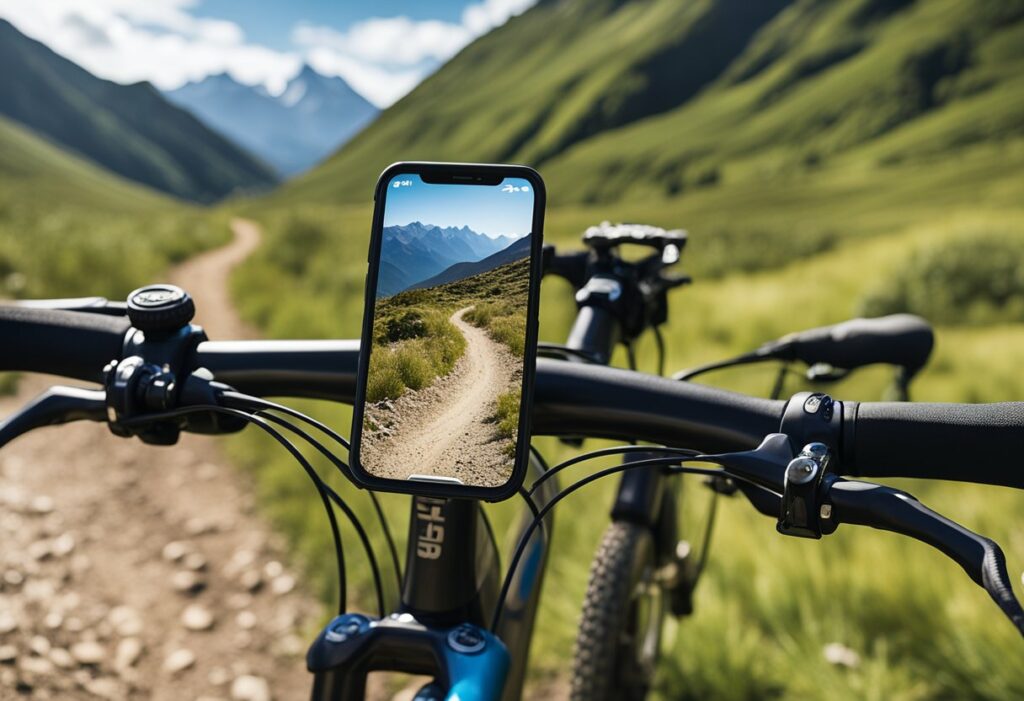
As you progress in mountain biking and move beyond the basics, your choice of bike becomes more critical based on the type of riding you prefer.
- Trail Bikes: These are versatile and can handle a variety of terrains. They make a great next step as you further develop your skills.
- Downhill Bikes: Built for speed and challenging descents, these bikes are for adrenaline seekers ready to tackle steep, rocky paths.
- Enduro Bikes: A mix between trail and downhill bikes, enduro bikes support the thrill of downhill but can still pedal uphill.
When considering hardtail bikes versus full-suspension bikes, it ultimately depends on the terrain and your riding style:
- Hardtail Mountain Bikes
- Great for beginners to intermediate riders.
- Offer direct trail feel and are efficient on climbs.
- Require you to develop strong bike handling skills.
- Full-Suspension Mountain Bikes
- Best suited for more technical trails.
- Provide increased comfort and traction.
- Generally more expensive, but worth the investment as your skills improve.
Remember to also upgrade your skills with your bike. Workshops or advanced riding courses can provide valuable tips and techniques to handle tougher trails with confidence. And always, your safety should remain a top priority; wear proper gear and know your limits. Happy riding!
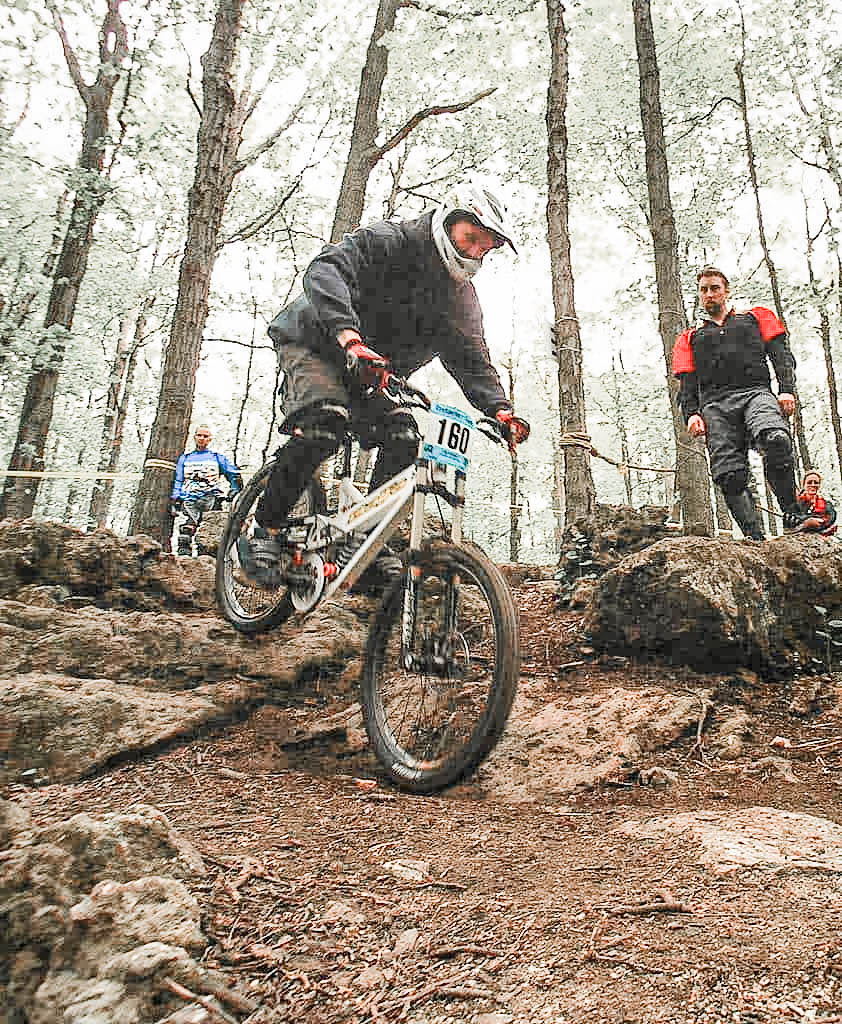
Tim is the founder of SimpleMTB and has been mountain biking for decades. He raced in the Ontario Cup series during his teenage years and riding continues to be one of his favorite hobbies now as an adult.
